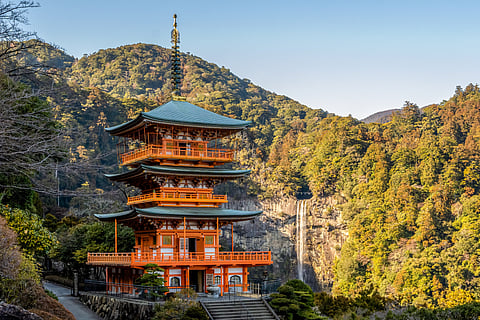
- Destinations
- Experiences
- Stay
- What's new
- Celebrating People
- Responsible Tourism
- CampaignsCampaigns
- Subscribe
- Buy Now

In Japan, the Kumano Kodo Pilgrimage stands as one of the country's most cherished sites winding through the lust mountains and historic shrines of the Kii Peninsula. For over a millennium, pilgrims have flocked to this UNESCO-listed trail that offers a singular fusion of spiritual contemplation, cultural legacy and scenic beauty. Immersed in the mystery of Japanese spirituality, the Kumano Kodo is a terrific experience for anyone looking for a route that is off the beaten track.
The origins of the Kumano Kodo may be traced back to the Heian Period (794–1185) in Japan, when emperors and other nobles made pilgrimages to the three magnificent shrines of Kumano, known as Kumano Hongu Taisha, Kumano Nachi Taisha and Kumano Hayatama Taisha. In line with Buddhist and Shinto beliefs, this area came to represent spiritual rebirth and purification. As time went on, these routes opened up to individuals from different backgrounds, encouraging inclusivity in spiritual practice. The Kumano Kodo's cultural value and standing as a symbol of spiritual pilgrimage were acknowledged in 2004 when it was listed as a UNESCO World Heritage Site.
Exhibiting a myriad of trails instead of a single path, the Kumano Kodo is a place where each route in the network has its own special qualities and degree of difficulty. The Nakahechi Route, often called the Imperial Route, is one of the most well-liked. It provides a somewhat difficult walk from Tanabe to Kumano Hongu Taisha. However, the Kohechi Route is a more difficult path that crosses rugged mountainous terrain to connect Koyasan to the Kumano shrines. The Ohechi Route extends along the southern coastline, combining mountainous scenery with seaside vistas, while the Iseji Route, a coastal walk, connects Ise Shrine with Kumano and provides stunning views of the ocean. The spiritual character of the journey is enhanced by the ojii shrines, which are tiny sacred checkpoints scattered along each trail where pilgrims can relax and pray.
The three magnificent shrines of Kumano, often referred to as the Kumano Sanzan, are the focal point of the Kumano Kodo pilgrimage. At the meeting point of the paths, Kumano Hongu Taisha is well-known for its massive torii gate, which represents the entry to the sacred. The harmony between environment and spirituality is symbolised by Kumano Nachi Taisha, which is located close to Nachi Falls, Japan's tallest waterfall. Located in Shingu City, the third temple, Kumano Hayatama Taisha, is well-known for its ancient sacred tree, which is thought to be more than 800 years old. The spiritual vitality of Kumano is embodied by five shrines collectively, which mirror the pilgrimage's ideals of rebirth and interdependence.
While being physically demanding, walking the Kumano Kodo is an immersive experience. A diversely changing vision of natural beauty is formed by the paths, which meander past terraced rice fields, bubbling hot springs, peaceful villages, and dense cedar forests. The voyage is profoundly contemplative due to the meditative mood created by the tranquil soundscape of rustling leaves, chirping birds, and running streams. Bell-adorned walking sticks, which are thought to fend off evil spirits, are frequently carried by pilgrims. Along the route, hot spring resorts and traditional inns called ryokan offer a chance to relax and revitalise while fusing the spiritual and the physical.
The Kumano Kodo is notable for its rich history and openness. It reflects Japan's syncretic spiritual legacy by embracing both Buddhist and Shinto traditions, in contrast to many other religious pilgrimages. Along with Spain's Camino de Santiago, it is one of only two pilgrimage routes in the world to be listed as a UNESCO World Heritage Site. The trek is made even more meaningful by the oji shrines that line the pathways. These little shrines serve as spiritual checkpoints where pilgrims can stop, pray, and make offerings, establishing a rhythmic bond between the sacred and the traveller.
Every season has its own distinct appeal, making the Kumano Kodo a year-round destination. Cherry blossoms bloom in the spring, while the pathways are covered in a painting of colourful leaves in the autumn. While winter delivers fresh air and calmer roads, summer brings abundant foliage, albeit with more humidity. The best times to go are April through June and September through November, when the trails are at their most attractive and the weather is at its most comfortable.
It is not too difficult to get to the beginning of the Kumano Kodo pilgrimage. The primary entry ports are Tanabe City and Shingu City, both of which have excellent train connections from Osaka, Kyoto, or Tokyo. It's simple to start the adventure from Tanabe because local buses run to important trailheads like Takijiri-oji.
